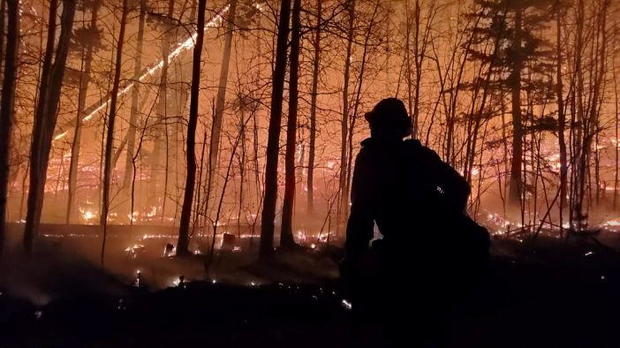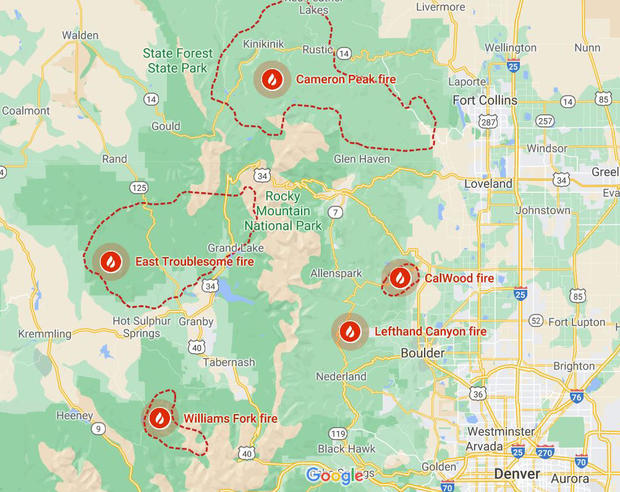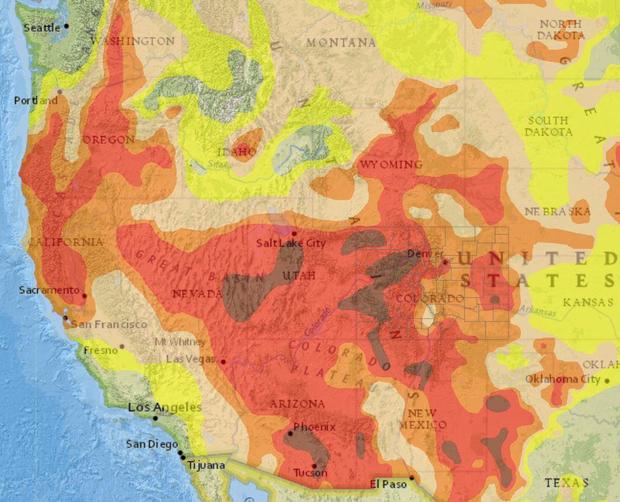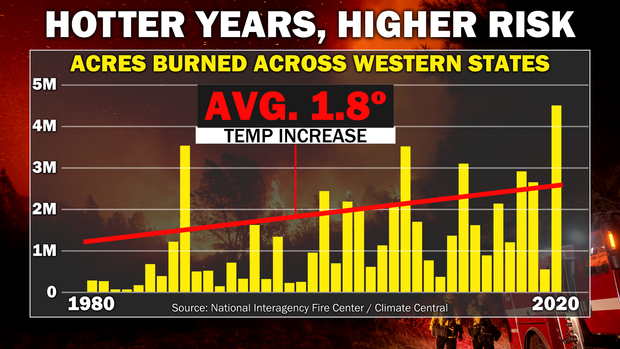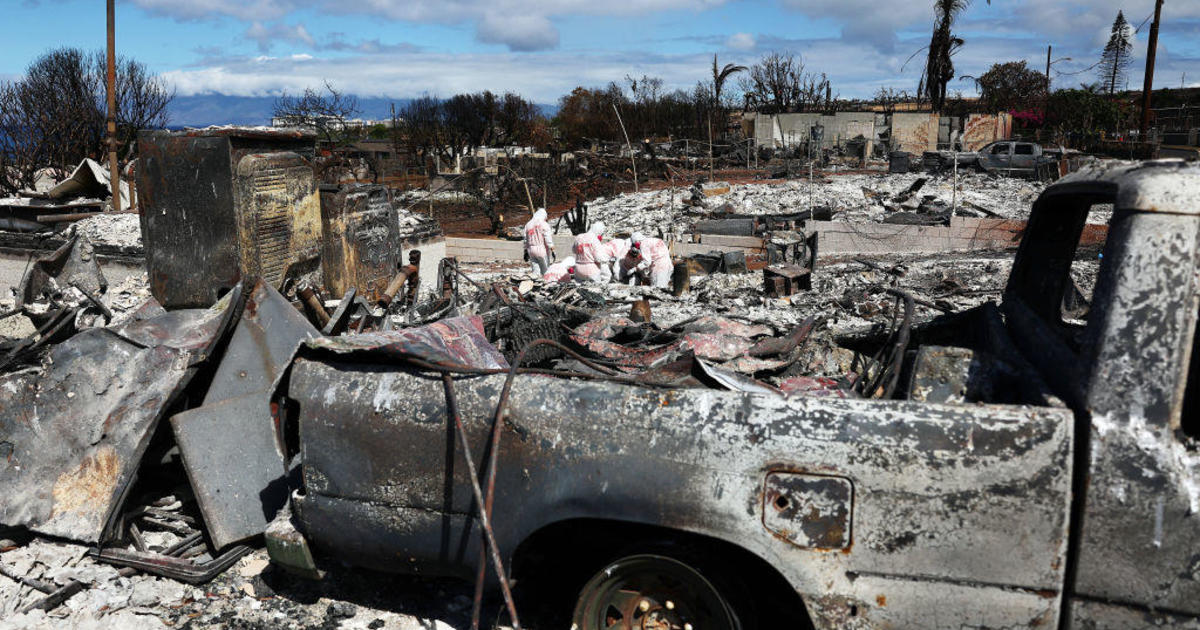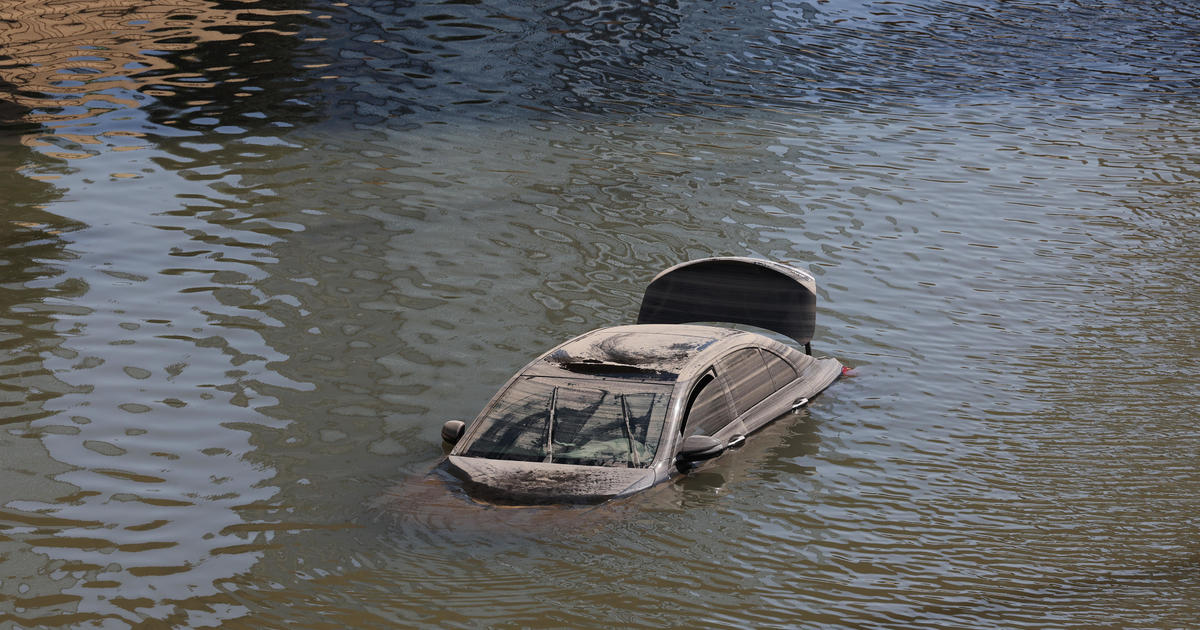Colorado's record-breaking wildfires show "climate change is here and now"
From Wednesday night into Thursday morning the East Troublesome fire in Grand County, Colorado exploded from 19,000 to 125,000 acres in just 12 hours, driven by wind gusts of up to 60 mph. It is now the fourth biggest fire in state history.
Just north of there, the Cameron Peak fire, a few miles west of Fort Collins, has engulfed over 207,000 acres and it's still growing. It has now become the biggest wildlife in Colorado history.
The Cameron Peak fire is actually the second fire in 2020 to hold the title of largest wildfire in Colorado history. The Pine Gulch fire near Grand Junction briefly held that title, but for only 7 weeks, having burned 139,000 acres in late summer. Now 3 of the top 4 largest wildfires in Colorado history have all burned in 2020.
Looking at this in a vacuum, you might think of it as mere coincidence. But zooming out, you need only look two states away in California to find evidence of more unprecedented fires. Six of the 7 largest wildfires in California history have all burned in 2020, and the largest, the August Complex fire, became the state's first ever gigafire — meaning it burned over 1 million acres, scorching more acreage than the state of Rhode Island.
This year Mother Nature has supplied us with smoking-gun evidence to prove what climate scientists have been warning about for decades. The scorched-earth impacts of climate change have arrived.
In a letter the editor published in the journal Global Change Biology, two of the world's foremost experts on wildfires conclude that the "[r]ecord-setting climate enabled the extraordinary 2020 fire season in the western United States."
"Our 2020 wildfire season is showing us that climate change is here and now in Colorado. Warming is setting the stage for a lot of burning across an extended fire season," says Dr. Jennifer Balch, professor of fire ecology and director of Earth Lab at the University of Colorado Boulder.
According to Balch, Colorado in the 2010s saw a tripling of average burned area in the month of October, compared to the prior three decades of the 1980s, 1990s and 2000s. "We do see fall fire events in Colorado, related to fast, downslope winds. But to see multiple events start this late, in the middle of October, is very, very rare."
Perhaps it's rare, but as of Monday 10 notable fires are burning across the state. The Cameron Peak fire's eastern extent is just 5 miles from Fort Collins and Loveland.
Two of the most concerning new fires are burning in Boulder County and forcing evacuations. The CalWood fire — the largest fire ever in Boulder County — and the Lefthand fire have both exhibited extreme fire behavior, shocking even seasoned climate scientists.
"Even as a scientist studying extreme weather & wildfire in a warming climate, I was shocked by how fast #CalwoodFire roared down the Colorado Front Range foothills," Daniel Swain, a climate scientist at UCLA, wrote on Twitter, posting video of a swirling vortex of smoke.
Examining all the evidence, it's clear why conditions are extraordinarily flammable this fall. It's a compound issue of short-term natural climate variability layered on top of fundamental changes to the long-term climate from global warming.
"This year was shocking"
While you can't completely separate short-term variability from longer-term climate trends, as they are intertwined, a region's most recent weather conditions are a big factor in how extreme a fire season is.
According to the Colorado Climate Center at Colorado State University, for the first time since 2013 all of Colorado is experiencing drought. This is no run-of-the-mill dry spell — 97% of the state is in the "exceptional," "extreme," or "severe" drought categories. And it's not just Colorado; much of the Southwest is bone dry.
Brad Udall, the senior water and climate research scientist at the Colorado Water Institute at Colorado State University, said 2020 started out promising.
"This year was shocking because we had a decent winter and on April 1 we had 100% of snowpack," he said. But things quickly turned disappointing. "With 100% of snowpack, you'd expect a decent runoff year. Instead, we ended up with 52% of what is normal."
The amount of water that runs off from snow cover, and the pace at which it melts, is important because it determines water availability for soil and vegetation in summer.
Udall says much of the poor runoff is a result of increased evaporation due to a very warm and dry spring and summer. Over the past few months there have been a number of significant heat waves in the West, two of which were of historic proportions. The extra added heat energy vaporizes spring snow cover, and the lack of new moisture provides nothing to buffer the loss.
In the Southwestern states, June through August rainfall was the lowest since 1895 and temperatures were the highest since 1895, according to NOAA. In Colorado so far, this year is the eighth warmest and second driest on record. Denver has experienced more 90-degree days than any year in its history.
"We've had next to no moisture over the last 3 months which is highly unusual. The Arizona monsoon often carries moisture to Colorado but this year it was a complete bust," said Udall.
The below map illustrates just how "off the charts" the atmosphere's demand for evaporation is. The more the atmosphere pulls moisture from the land, the drier and more flammable the trees, grass and brush become.
Udall says that while most of the droughts of the 20th century were caused by lack of rainfall, today's droughts are mainly caused by increased evaporation due to warmer weather. But drought is usually referred to as a short-term issue, and what's happening in Colorado is not temporary. He prefers the term aridification, because climate change, due to the burning of fossil fuels and the buildup of a heat-trapping carbon pollution blanket overhead, is systematically drying out the landscape.
To be sure, climate is not the only factor driving the explosion in burned area. Excess fuel buildup due to increased fire suppression in recent decades as well as increasing ignitions due to more human activity in forested areas do play a role. But experts say the marked increase can not be explained without longer-term warming and drying.
Climate change and "the recipe for large forest fires"
If you look back over the past century, parts of Colorado have been warming faster than anywhere else in the nation. According to data from NOAA and an analysis by the Washington Post, western and northern Colorado are warming at twice the average rate of the globe, having warmed about 3 to 5 degrees Fahrenheit since 1895.
A study published in September found that the frequency of combined heat waves and droughts — which are more impactful when they occur in unison — has increased significantly, especially in the western U.S. For example, the type of hot-dry event that would have been expected once every 25 years in 1950, now occurs five to 10 times every 25 years.
"Episodes of extreme dryness and heat are the recipe for large forest fires," said Mojtaba Sadegh, the senior author of the study. "These extremes are intensifying and extending at unprecedented spatial scales, allowing current wildfires to burn across the entire U.S. West Coast."
Colorado's state climatologist Russ Schumacher agrees, telling Colorado Public Radio this is pretty well in line with climate predictions, "What we're seeing here is indicative of the fact that when the hot, dry years come around, they're hotter. ... I think the frequency of these kinds of summers where we get in these hot, dry conditions is probably going to increase."
Udall agrees, and warns we should get used to what he calls "the new abnormal." "The climate system has a really good memory and the cycle of heat and dryness is hard to break," he said.
Since 2000, the drought in the Western states has become so monumental that scientists are using the term "megadrought" to describe it. This spring climate scientists released a groundbreaking study saying that this is the beginning of the second worst drought in the past 1,200 years, with a "large contribution from human-caused climate change."
The graph below from drought.gov shows that over the past 20 years drought has become a regular and potentially permanent part of Colorado's climate. Darker shades mean drier conditions, with D2 representing "severe drought, D3 "extreme drought" and D4 "exceptional drought."
The effects on the Colorado environment are apparent. Since the 1930s the water available from Colorado snowpack has decreased by 30%. As a result streamflow in the Colorado River has decreased markedly. In a 2018 study, Udall and co-authors found that 50% of the river runoff decline was due to higher temperatures.
And this more arid climate has huge impacts, with larger wildfires and a longer fire season. In fact, wildfire season in the West is now two to three months longer than it was in the 1970s. And since 1984, human-caused climate change has led to a doubling of the area burned in the Western states, with about 50%of the increase being attributed to increases in the dryness of fuel.
A 2015 study on wildfires in the Colorado Front Range Corridor found that the expansion of the wildland-urban Interface — more people living on the edge of forests — and climate change were both to blame in explaining the changing fire trends, but that climate change had a "stronger influence."
Balch says that our inability to square the needs of our modern society with a rapidly changing climate is a dangerous proposition.
"Ignoring the link between warming and wildfires only puts lives and homes at risk," she said. "In the contiguous U.S. 1 million homes sat within the boundaries of wildfires in the last 24 years. Nearly 59 million more homes in the wildland-urban interface lay within a kilometer of fires."
The unprecedented wildfires of the past few years have certainly illuminated just how vulnerable we are to a climate which no longer plays by the rules our parents and grandparents took for granted. And considering the warming and drying projected in the coming decades, scientists say the rules will just keep on changing, making it "unlikely that the records from 2020 will stand for long."
